Last updated: April 13, 2023
Article
Elephant Seal Monitoring Season Summary: Winter 2022-2023
Season Highlights
- The beach in front of The Ken Patrick Visitor Center (KPVC) once again became an elephant seal haul out site this breeding season, likely in response to the intense storms in early January.
- Similar behavior was observed in 2019 and 2021
- These storms caused the peak of pupping to lag about a week behind last year’s peak.
- This year’s oldest female and male whose tags were resighted:
- Pink tag K847:17-year-old female
- Pink tag N665: 11-year-old male
- As of March 17th, NPS researchers have tagged over 420 weaned pups!
- This season NPS researchers also supported projects out of UC Santa Cruz, Sonoma State University, and The Marine Mammal Center.

NPS / Sarah Allen, NMFS Permit No. 21425
Visitor’s View
Park staff normally use deterrence methods to prevent females from pupping on the beach in front of KPVC, but given the intensity of this season’s storms staff decided to let the harems shelter in place, with efforts focused on keeping the parking lot as seal free as possible. Consequently, Drakes Beach was closed completely this breeding season, but visitors had great views of the newborn pups, nursing cows, and males of all age classes. Turns out the invasive ice plant (Carpobrotus edulis) makes a wonderful nursery! Near the season peak, 77 females were present and 62 pups were nursing.

NPS / Matt Lau, NMFS Permit No. 21425

NPS / Matt Lau, NMFS Permit No. 21425

Elephant Seal Annual Cycle
While the breeding season is the most populous and active time for elephant seals at Point Reyes, seals can be seen in the park all year round! Elephant seals come on shore twice a year: adults come to breed and then to molt, while juvenile seals come onshore for the “juvenile haul out” and to molt. Some individuals may look particularly rough and shaggy during the molt, but after a few weeks their coats will grow in full and healthy!
By the Numbers
Elephant Seal Breeding Season Peaks, 2011-2023 (from direct ground counts)
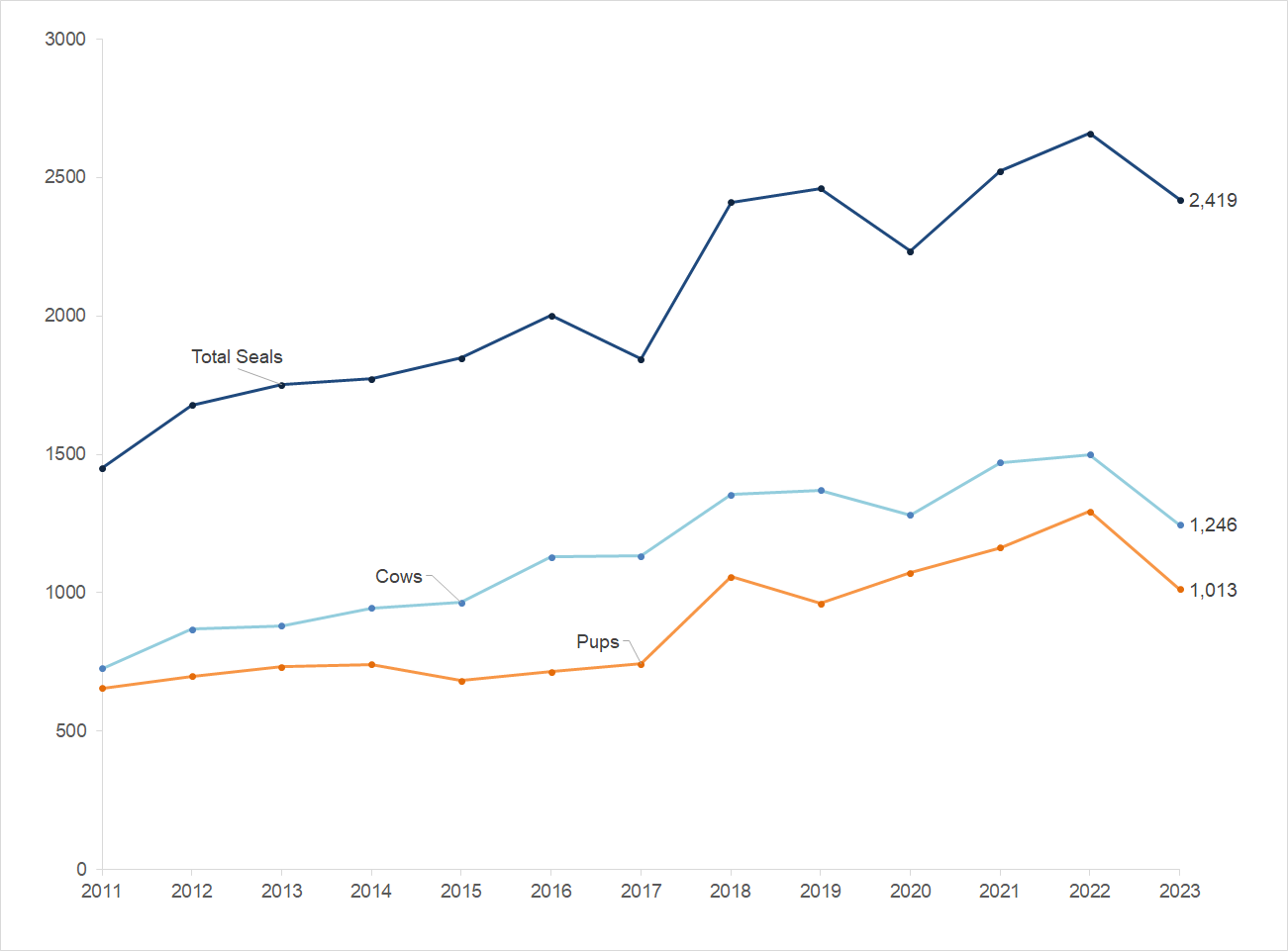
Total Elephant Seal Counts, Winter 2022-2023
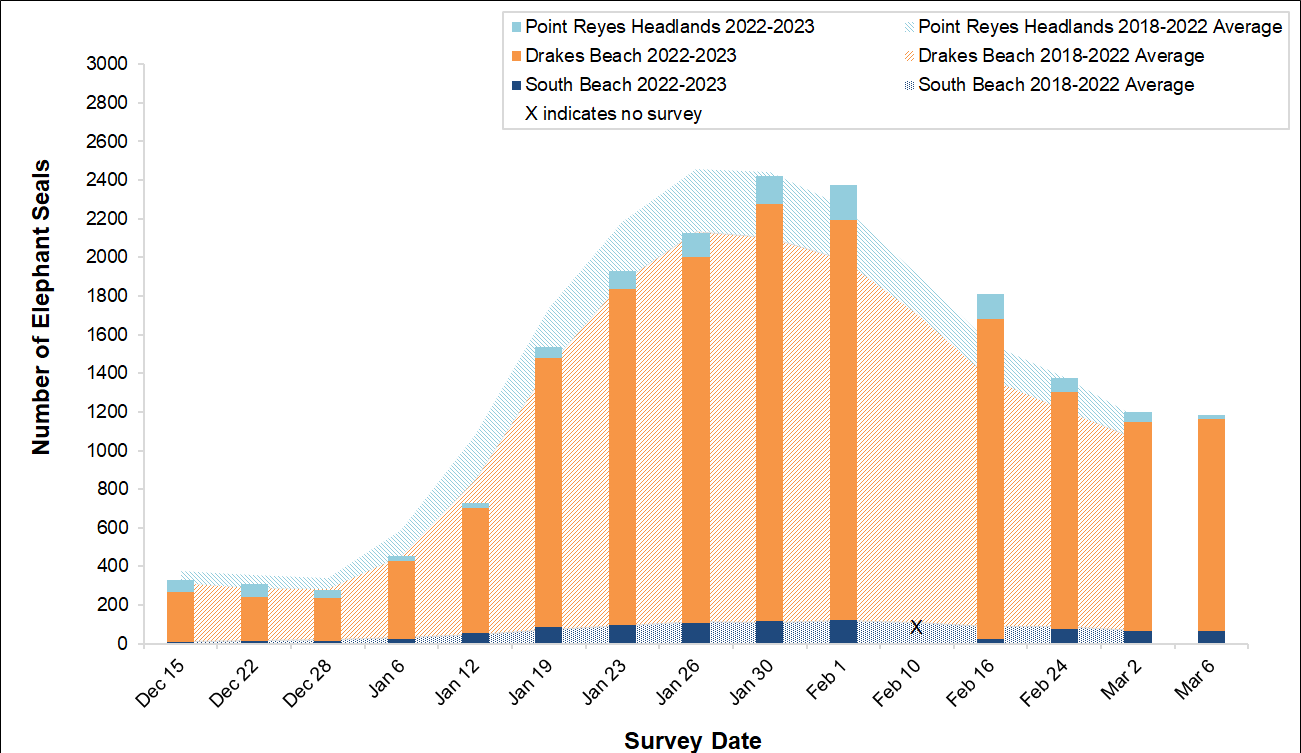
Female Elephant Seal Counts, Winter 2022-2023
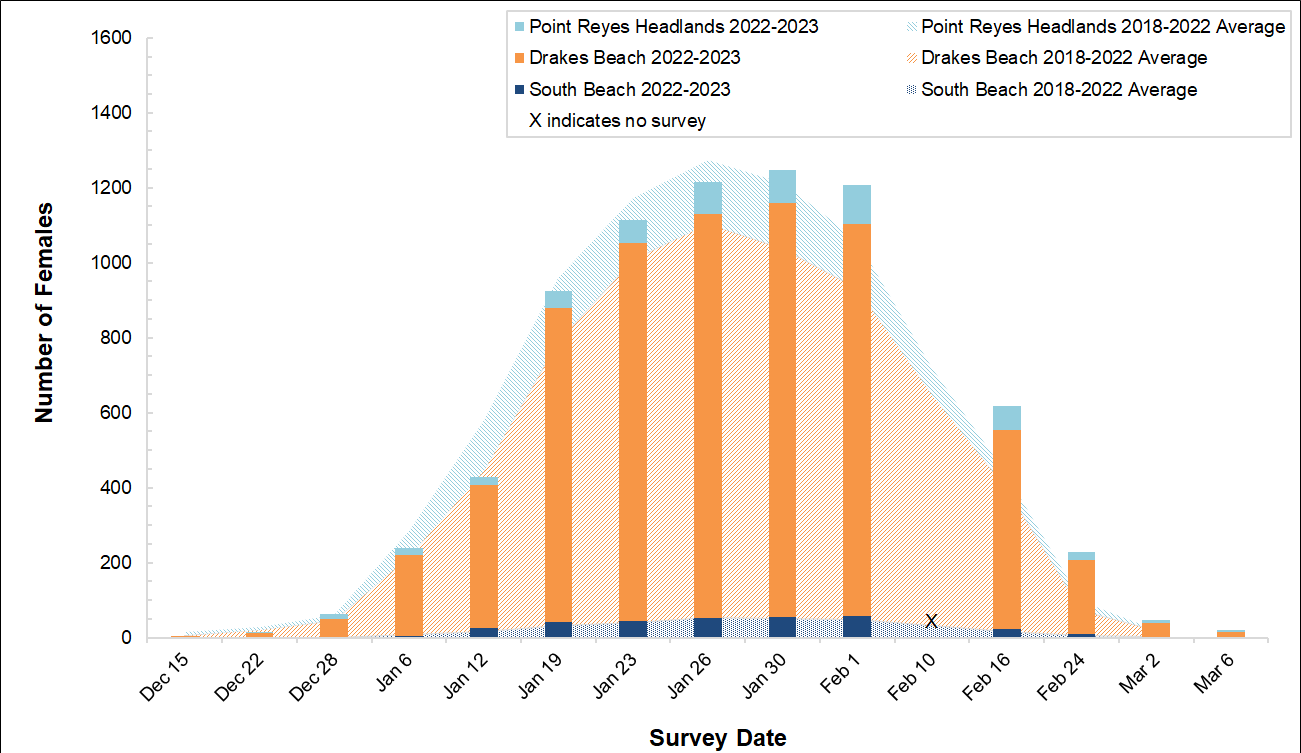
Elephant Seal Pup Counts, Winter 2022-2023
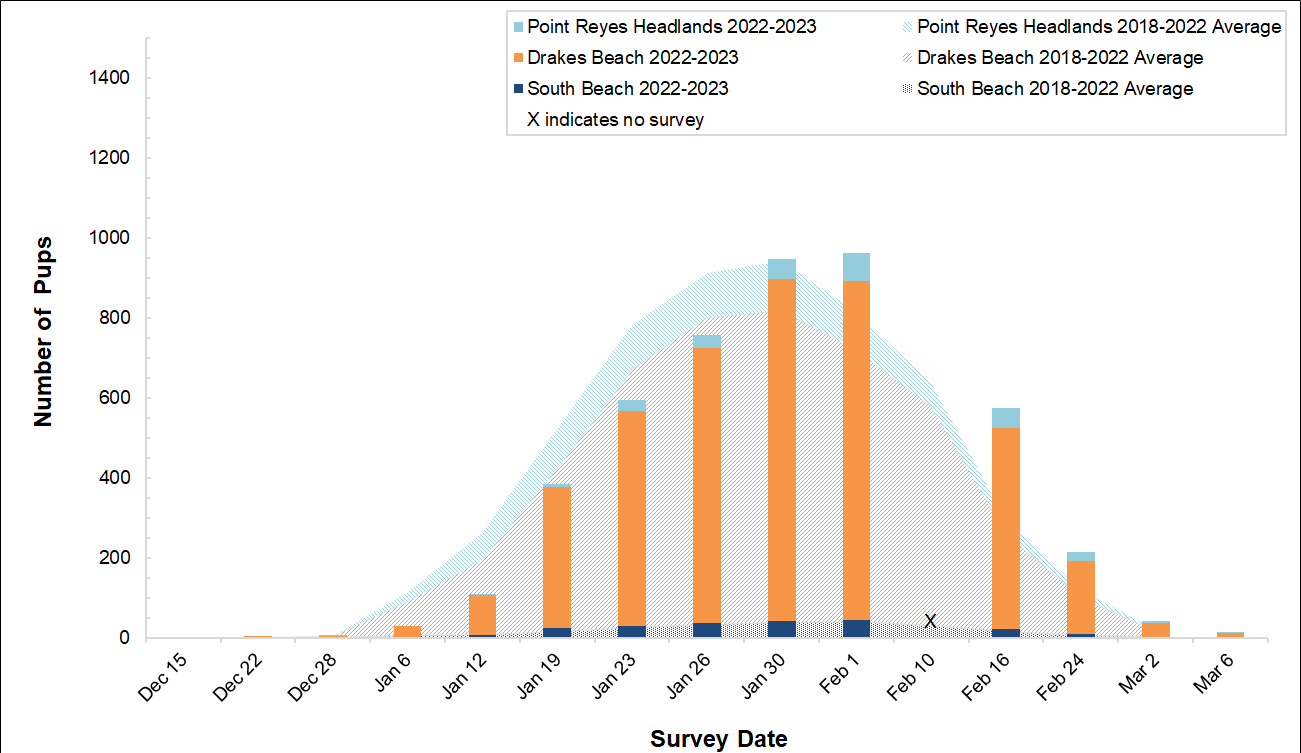
Elephant Seal Weaned Pup Counts, Winter 2022-2023
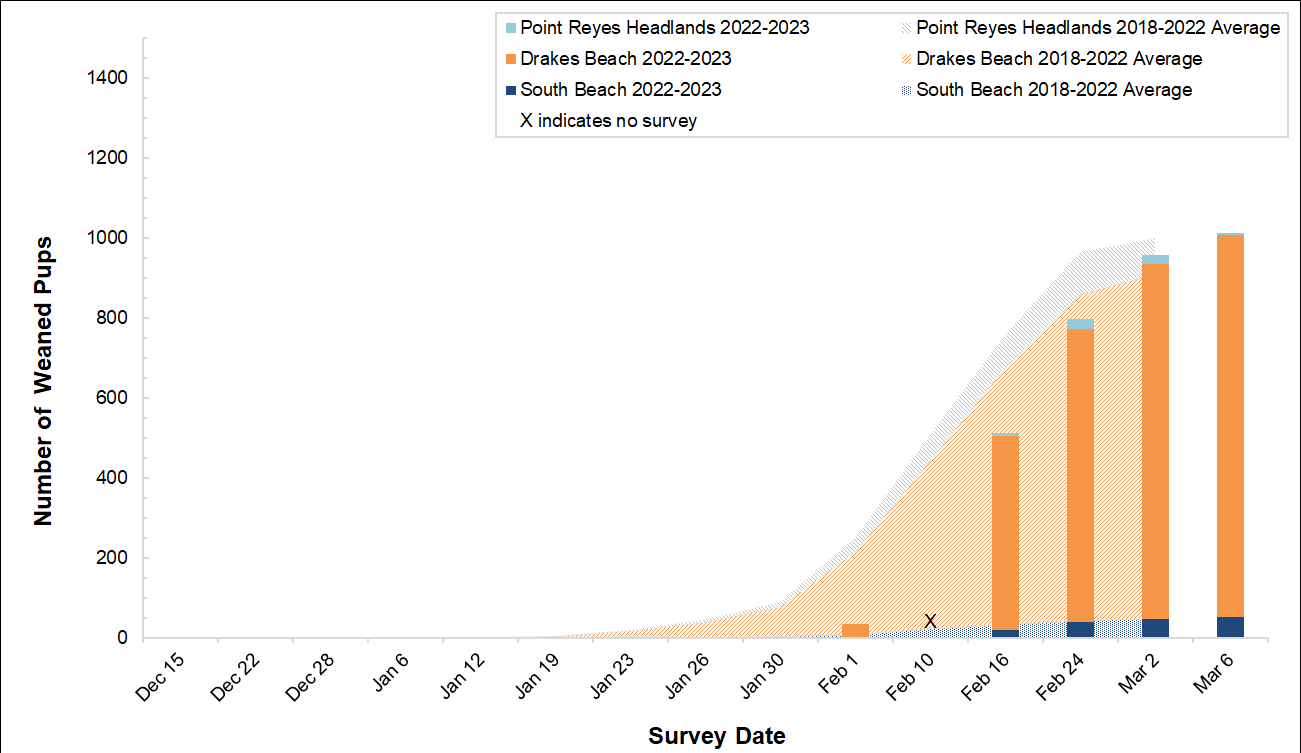
Weekly Updates Recap
News This Week
- The elephant seal first pup of the season was born at Chimney Rock Cove West on Dec. 20th!
- We have since recorded 107 pups born, and we expect many more in the weeks to come.
- Unprecedented weather this past week has prevented biologists from discouraging seal presence near the Ken Patrick Visitor Center.
- Drakes Beach Road is currently closed, but we are working to open access to the public soon!
Pup Basics
- Pup Birth Weight: 60-75 lbs.
- Pup Birth Length: 3.2-4 ft.
- Nursing Duration: approx. 28 days
- Weaned Pup Weight: approx. 300 lbs. (Talk about a growth spurt!)
News This Week
- Female elephant seal arrivals and pup births are ramping up!
- Gus’ Cove is a popular nursery for new moms this year. Given recent storms and tides Gus' Cove provides ample protection for newborns. Over 250 cows were counted there this week, which is the most ever recorded for this small beach.
Baby on Board!
After approximately seven months foraging in the open ocean, female seals show up on Point Reyes beaches to give birth.
Northern elephant seals have a high rate of natal fidelity, which means they often return annually to the same colony and even the exact beach where they were born.
Little is known about elephant seal labors, but researchers witnessed a birth this week in front of the Ken Patrick Visitor Center and a birth was caught on camera at the Lifeboat Station!
To see more archived videos and photos, and to continue watching more of the new Lifeboat Station pup streamed in partnership with The Marine Mammal Center, you can find the home page for the archives here: Point Reyes National Seashore, Point Reyes, CA | WebCOOS.
You can also find a link to the live-stream on YouTube at our website: Historic Lifeboat Station Webcam - Point Reyes National Seashore (U.S. National Park Service) (nps.gov)
And definitely check out the Ken Patrick Visitor Center area to see the many elephant seals that have taken over that beach (and sometimes the parking lot). The parking lot is now open to the public every day, 10am - 4pm.
News This Week
- The Ken Patrick Visitor Center at Drakes Beach is now open! You can check out the elephant seal viewing areas 10 am to 4 pm every day of the week.
- We’ve got a weanling! This year’s first weaned pup was recorded last week.
- After 25 to 30 days, pups finish nursing so their moms can return to the sea to forage. Females fast the duration of nursing and can lose approximately 40% of their body weight.
That's Got to Hurt!
- Seals often sustain and survive a variety of injuries just like we do! Injuries are typically caused by sharks, boats, or fishing gear/marine debris.
- This week, National Park Service researchers and The Marine Mammal Center staff investigated a possible entanglement on a sub-adult male. Fortunately, the wound was free of any fishing line or plastic, so they will continue to monitor the healing process.
- If you see any marine mammals with entanglements, please contact park staff or The Marine Mammal Center.
News This Week
- While elephant seal pups will be born until mid February, this week we likely reached the peak of pupping season!
- Soon the beaches will be filled with weaned pups. National Park Service researchers are prepping to tag these weanlings before they begin their first foraging season at sea.
- Before they leave, weaned pups will molt their dark black fur which keeps them warm while they nurse on shore.
Special Guests!
- NPS staff joined UC Santa Cruz (UCSC) researchers to collect data from an adult female elephant seal on Drakes Beach.
- This seal gave birth at Año Nuevo Reserve last year, where UCSC researchers attached a satellite tag on her to track her movements out at sea. They were surprised to see she traveled to Point Reyes this season to pup despite typical species behavior of site fidelity.
- The Beltran Lab at UCSC collaborates with other parks and researchers to monitor northern elephant seals. Check out her website to learn more.
News This Week
- Due to the tides not being very low this week, NPS biologists were unable to conduct an elephant seal census.
- Now that cows are beginning to wean their pups, they will soon mate before starting their annual migrations.
- Male seals are becoming increasingly aggressive towards each other as they battle for mating rights.
- Alpha bulls will protect harems of cows from subordinate bulls and subadults.
- Powerful battles can turn bloody quickly, but males develop a chest shield (thick cornified skin) with age and experience, which helps protect their chests.
Tag, You're It!
- On Thursday, NPS researchers completed their first tagging session at Drakes Beach in front of the Ken Patrick Visitor Center.
- A tool is used to place tags, which have a unique code, in the interdigital webbing of the rear flippers. It’s like an ear piercing - just a pinch!
- Researchers along the coast apply tags and perform tag resights to identify individuals as they travel. Tag colors are site specific:
- Pink – Point Reyes and Farallon Islands
- Green – Año Nuevo
- White – San Simeon/ Piedras Blancas
- Blue – King Range in the Lost Coast area
- Tag resight data is helpful to understand trends in pup mortality, life expectancy, site fidelity, and reproductive success.
News This Week
- Female elephant seals only give birth to a single pup each season; however, they may nurse more than one as some pups can become separated from their mothers in large harems. Even weaned pups can sneak in to take advantage of remaining lactating cows.
- Peak pupping has passed, and some females are mating and returning to the ocean to feed during their post partum recovery before arriving back to shore to molt in the spring.
- Now weaned pups are filling up the beaches!
- While performing tag resight surveys NPS researchers have identified some older individuals:
- Pink tag K847:17-year-old female
- Pink tag M432: 14-year-old female
- Green tag 4118: 14-year-old female
- Pink tag N665: 11-year-old Bull
- Females tend to outlive males by approximately 9 years!
News This Week
- Keep an eye out for aggressive male elephant seals as mating continues on the beaches.
- Weaned pup pods are forming as there are now nearly 800 weanlings in the park.
- A sub-adult male was spotted on Thursday morning (2/23) near the Ken Patrick Visitor Center with some nasty shark bites.
Let's Dive Deep!
Elephant seals are known for their diving capabilities. How do they do it and prevent decompression sickness (the bends)—a barotrauma caused by nitrogen gas bubbles in the blood - when ascending from depths typically between 300-800 meters? The bends comes from air consumption while diving, so seals aren’t at risk because they aren’t breathing underwater like a SCUBA diver does. Also, seals exhale before descending, so there is no leftover air in the lungs to provide excess nitrogen absorption. Decreased heart rate, high concentrations of hemoglobin and red blood cells, and limited circulation to the extremities slow nitrogen uptake into the tissues and decrease oxygen depletion.
News This Week
-
Most female elephant seals have returned to the ocean to break their breeding season fast, but many males—especially bulls—remain to increase their chances of mating with any females departing late.
- With the longest fast duration of approximately three months, males spend lots of time resting on the beach to conserve energy. They typically only exert themselves to battle and protect their harems.
- The Marine Mammal Center (TMMC) staff and National Park Service researchers collected fecal swab samples from weaned pups this week. TMMC veterinary staff are exploring the intestinal microbiome of newly weaned pups.
Pregnancy Pause!
Elephant seals spend most of their lives at sea, only coming to shore to breed and molt. Females produce approximately 138 kg of milk for their pup over the course of a month; however, milk production varies depending on female size, age, activity in the harem, and reproductive experience. The milk has a consistent amount of protein at 10%, but fat content increases over time from an initial 15% to a 55% peak. This milk is incredibly rich - especially compared to human breastmilk which is around <1% protein and 5% fat - which allows pups to quickly gain weight, but results in rapid weight loss for the mothers who can lose up to 40% of their body weight while nursing.
Mating occurs at the end of the nursing period when a female is weaning her pup, but she is much too thin to support a pregnancy. How do the seals overcome this challenge? After mating, egg implantation is delayed for two and a half months while the females forage and then molt in April and May. After molting, the egg implants and females spend the entirety of the gestation period, seven to eight months, foraging in the open ocean.
News This Week
- On Monday, a brave yearling made its way up near the restrooms of the Ken Patrick Visitor Center! If you ever encounter a seal in an unfavorable location, please keep your distance and contact park staff.
- The number of weaned elephant seal pups in the park continues to grow with over 1,000 counted on Monday, March 6th. Park researchers are busy tagging these young seals—the goal is to tag around 400 to 500—in hopes that they will be spotted again in the future!
To Fast or Not to Fast!?
Adult elephant seals fast twice per year during the molting and breeding seasons, but why? The seals have a preference for prey in deep waters, so fasting allows for shorter breeding and molting seasons which means they can spend more time in preferred foraging waters during the remaining months. During the breeding season, males could lose their harems to competing males and females could lose track of their pups if they were to split their time between foraging and hauling out. Also, there are no natural predators on land, so the seals don’t have to worry about outswimming sharks or orca pods. The safest place for them during these vulnerable seasons is on shore! Lastly, extremely large seals have a hard time ascending from dives. These periods of fasting ensure the seals have enough blubber to keep them warm, but not so much that it impedes their foraging and diving abilities.
Elephant Seal Seasonal Monitoring Updates Home >>
Elephant Seal Colonies and Beach Closures Map >>
The National Park Service shall not be held liable for improper or incorrect use of the data described and/or contained herein. These data and related graphics are not legal documents and are not intended to be used as such. The information contained in these data is dynamic and may change over time. The data are not better than the original sources from which they were derived. It is the responsibility of the data user to use the data appropriately and consistent within the limitations of geospatial data in general and these data in particular. The related graphics are intended to aid the data user in acquiring relevant data; it is not appropriate to use the related graphics as data. The National Park Service gives no warranty, expressed or implied, as to the accuracy, reliability, or completeness of these data. It is strongly recommended that these data are directly acquired from an NPS server and not indirectly through other sources which may have changed the data in some way. Although these data have been processed successfully on computer systems at the National Park Service, no warranty expressed or implied is made regarding the utility of the data on other systems for general or scientific purposes, nor shall the act of distribution constitute any such warranty. This disclaimer applies both to individual use of the data and aggregate use with other data. The National Park Service requests that the data user refrain from publishing these data and related graphics and wait until data is available in official, published reports.
